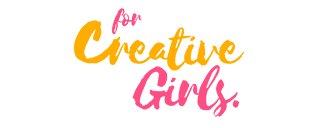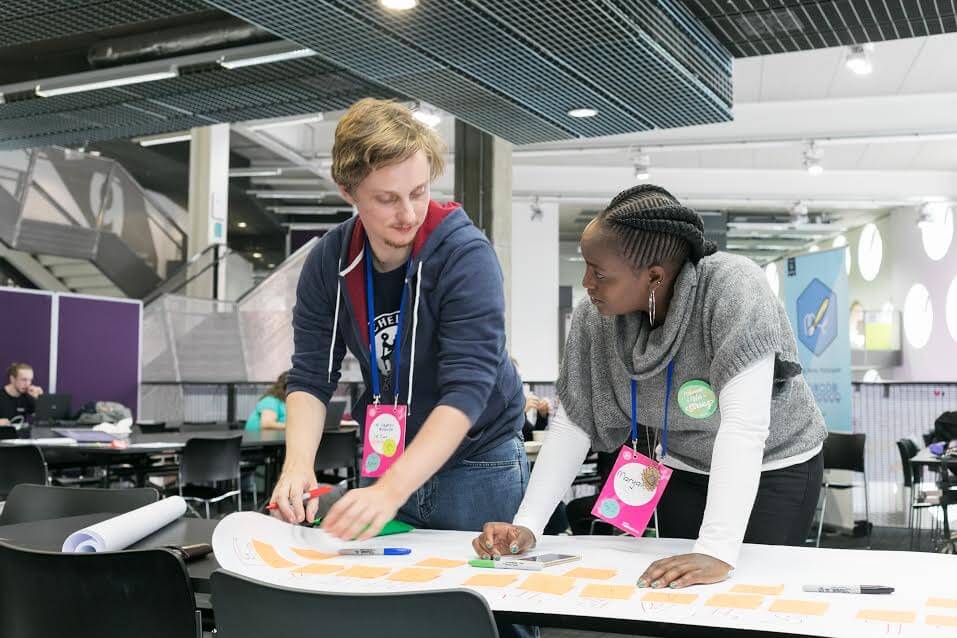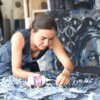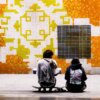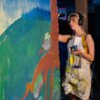Maryann Wangari is a Nairobi-based multi-disciplinary creative designer, digital crafter, and storyteller emphasizing on user experience, design thinking, human-centered design, interaction Design, User Interface Design and product designs. She loves creating products that engage, inform and inspire people.
Maryann is a strong believer of the value of placing people first when designing from an end–user perspective, she believes that Design has the potential to transform careers, organizations, industries and people’s lives in general.
She has taken the lead role on projects with digital advertising agencies, corporates, and startups that deliver, new target operating models to establish products that impact change.
When Maryann is not working, she teaches young girls on web literacy under a program by Mozilla foundation and UN Women. She is one lady passionate about the intersection of design, technology and women empowerment.
For Creative Girls: We are curious, what was the first encounter that drew your heart to Design?
Growing up, I always wanted to be a lawyer! Yes a lawyer, but life has a different way of turning things around. Fast forward after high school, I had an opportunity to join a leading design school in Nairobi. Two years later I graduated as the best female student class of 2011. Graduating as the best student opened numerous opportunities and I interned and later work with some of the best digital advertising agencies in Kenya. I worked as UI/UX designer for four years, being a curious person I wanted to do more than just designing beautiful UIs’ I wanted to use design to inspire change. I started taking a lot of online courses on design thinking and Human Centered Design, one of my favorite courses was one offered by IDEO. Last year I took a job offer at Esoko as a product design Manager – Esoko uses technology to improve the livelihood of smallholder farmers in Africa. The opportunity came bundled with its own challenges coming from the digital advertising world to designing for smallholder farmers. I am excited to say that we are building what will be the ‘Alibaba’ for farmers in Africa.
Design Thinking as a concept and subject matter has evolved past Graphics and UX, what has led to this shift and where do you see the concept leading up to?
Design thinking is essentially about how designers think and what methods they employ in order to develop products, services or professional values. Different methods have emerged through the process of design and this evolution has led to a broader conception of design thinking in all domains of life.
As we look to the future, design thinking will play an increasingly critical role, and organizations will need to evolve and embrace this creative and agile practice if they are to stay ahead of the pack. I am excited about the future because design is playing a big role in solving some of the world’s most complex issues.
This brings us to Human Centred Design, involving the human perspective to all aspects of Design. In your opinion, how successful has the design community been in achieving this and how can HCD be incorporated more into systems/architecture?
I will use my favorite quote from Melinda gates on HCD and why it matters – “Human-centered design. Meeting people where they are and really taking their needs and feedback into account. When you let people participate in the design process, you find that they often have ingenious ideas about what would really help them. And it’s not a one-time thing; it’s an iterative process” Imagine if everyone – you, your neighbors, engineers, CEOs, companies, the government—became slightly more intentional, and slightly more human-centric, the world would be a better place.
I am a strong believer of the value of placing people first when designing from an end–user perspective, I believe that Design has the potential to transform careers, organizations, industries and people’s lives in general.
What’s your process/framework for approaching a new design or product?
My design process varies from one project to another but I use the following as a guideline to most of the projects I have worked on.
• Empathy: Understanding the needs of the users we are trying to solve for
• Define: what is the problem we are trying to solve
• Ideation: generating ideas and identifying new solutions to the problem statement
• Prototyping: early sample model or release of a product wireframes etc.
• Test: validating what has been build with the users.
I would like to mention that not all projects go through this process and sometimes it’s just a client trying to improve a functionality on their website, service or application the process vary from one to client to another based on what they are looking to achieve.
What struggles did you encounter when you first started designing? What has been some of the toughest glitches you’ve had to deal with in your career to this point?
Ha! there is nothing worse than losing all your work to a crashed OS on your computer. Sometime last year, I was trying to update an OS on my computer and somewhere in between power went off, I lost quite a lot of data and artworks.
My biggest challenge to date is keeping up with trends in a world where there is so much information to consume from blogs, books, videos etc. I am learning to filter information that fits my aspirations in life. I’m trying to find focus in such a distracted world. Anyone struggling with the same problem I would recommend reading a book “Manage Your Day-toDay: Build Your Routine, Find Your Focus, and Sharpen Your Creative Mind ” by Jocelyn K. Glei.
So, what’s your definition of Creativity? And what brand(s) or work has been your favorite so far?
For me, creativity is simply identifying challenges and coming up with solutions that solve these challenges. My favorite product so far is Google maps it has helped hundreds of millions of people plot billions of trips worldwide. I use google maps every day to check on traffic update, where to get food, directions and so on. When I’m not working, I’m out there looking for something to do, google maps is my go-to app for most places I visit.
UX Nairobi brings/convenes people interested in UX and design in Nairobi. What has been your experience so far in building a community around designers? And what peculiarities come with being a designer in Nairobi?
Africa needs better-designed products and services especially in sectors that traditionally lack design innovation like education, health, and energy. We can uniquely help accomplish this by bringing in together a community of designers with interests in using design to solve some our social challenges. Design has been under-represented in the country due to lack of a centralized community of creative thinkers. In Nairobi we have seen annual events like Dev Fest but nothing around design. Our aim is to bring all these people together through meetups and events. The community is still new and we are working with interested folks to make it work.
Do share a couple of your favorite work tools with us.
My Design kit consists of the following:
• Post it notes
• Sharpies
• Notebook
• Sketch book
• Pens and pencils
• My Mac book
• Adobe creative suit
• A few online prototyping tools
How would you advise new UX designers to navigate the field and grow in their work?
There’s no doubt that UX design is one of the fastest growing fields in recent years. Recently I wrote a post on LinkedIn on the growing need for user experience designers in Kenya, In the last two months, I have seen three major banks advertise for a UX position in Kenya. My advice to new Uxers’ taking on these challenges is to keep preaching the UX gospel, it will not be easy especially with companies that don’t appreciate the process. Before you quit your old job, think of some ways to improve the experiences of users in your current field. Your role changes constantly and every day the list of things you don’t know
grows. To survive, you have to be quick on your feet, learn as you go and figure out a process.
Tell us about 3 women you admire.
Michelle Obama : Beauty & brains, grace & glamor, smart & sexy. Thank you for inspiring women and girls all over the world Mrs. Obama.
Chimamanda Ngozi: I love everything about this woman, her writing is phenomenal and she is an absolute inspiration to all feminists around the world. In a society where diversity and inclusion of women and girls have highly been ignored, we need strong women like Chimamanda to remind us that we can do it.
I will dedicate the third slot to all the amazing women out there doing amazing work be it in tech or any other field. I get inspired when I watch or read articles on what women and girls are doing out there from amazing women like Caroline who built an organ marching app which was inspired by her uncle’s death to superstars like Lupita, to that young ballet dancer in Kibera using dancing to uplift her livelihood. The list is endless, and the sky is the limit.
I know you did not ask this but yes I Met Mark Zuckerberg two weeks ago during the Facebook developer conference in San Fransisco. 😀
Hahaha. Thank you, Maryann
Follow Maryann on Twitter, Behance, Dribble, and LinkedIn to experience her work and thoughts on Design.
